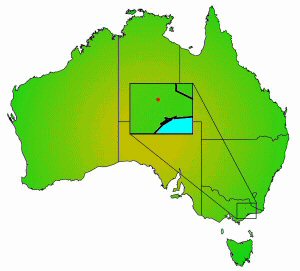Dargo galaxias facts for kids
Quick facts for kids Dargo galaxias |
|
|---|---|
| Conservation status | |
|
Critically Endangered (ASFB)
|
|
| Scientific classification | |
| Genus: |
Galaxias
|
| Species: |
mungadhan
|
The Dargo galaxias (scientific name: Galaxias mungadhan) is a small freshwater fish. It belongs to a group of fish called Galaxias, which are part of the Mountain Galaxias family. You can find this special fish only in Australia.
Contents
What Does the Dargo Galaxias Look Like?
The Dargo galaxias looks a lot like other fish in the mountain galaxias family. It has a long, tube-shaped body. Most of these fish are about 7 to 8 centimeters (about 3 inches) long. The biggest one ever found was about 11 centimeters (about 4.3 inches) long.
Its head is medium-sized, and it's wider than it is deep. The back of its body is flat behind its front fins. Its mouth is at the very tip of its snout and points slightly downwards.
The fins on its back (dorsal fin) and belly (anal fin) are short and rounded. They are usually about the same length. Its front fins (pectoral fins) are low on its body and shaped like paddles. They are longer than its belly fins (pelvic fins). The belly fins are located about halfway along its body. Its tail fin is a medium length.
The Dargo galaxias is usually dark brown all over. It's darker on its back, above the middle line of its body. Its belly is a lighter brown. It has irregular, blurry blotches on its body, especially above the middle line.
On the sides of its body, from behind its neck to its tail, there's a band of gold spots or flecks. These spots are usually below the middle line and are brightest near the tail. Its head also has many small gold flecks scattered across it.
Where Does the Dargo Galaxias Live?
The Dargo galaxias lives in a very small area. It's found in only about a 4-kilometer (2.5-mile) section of a creek. This creek is a small branch of the Dargo River, which is part of the Mitchell River system in Gippsland, Australia.
Scientists believe that this fish used to live in more places in the upper Dargo River. But then, brown trout were brought into the area. Brown trout are not native to Australia and can harm native fish like the Dargo galaxias.
What is Its Home Like?
The Dargo galaxias lives in a clear, cool creek high up in the mountains. This creek is quite small, usually about 0.5 to 1.3 meters (1.6 to 4.3 feet) wide. It's also shallow, about 5 to 40 centimeters (2 to 16 inches) deep. The creek has parts where the water flows fast (riffles) and deeper, stiller parts (pools). The pools are usually about 50 centimeters (20 inches) deep.
In winter, this creek is often covered with snow. The bottom of the stream is mostly solid rock and some large stones. There are also small amounts of pebbles, gravel, sand, and clay. The fish can hide among the rocks and under the alpine grasses that hang over the water.
How Does the Dargo Galaxias Live and Reproduce?
The Dargo galaxias spends its whole life in freshwater. It's the only native fish found in the part of the creek where it currently lives.
We don't know exactly when these fish lay their eggs (spawn). It might change each year depending on the weather and water conditions. However, scientists found that adult fish collected in April had eggs that were almost ready. This suggests they might lay their eggs in winter or spring. Also, finding young fish of different sizes at different times means they might have a long spawning season, from late winter to spring.
These fish are very tough! They can live in very cold water, even below 5 degrees Celsius (41 degrees Fahrenheit).
Why is the Dargo Galaxias Endangered?
The Dargo galaxias is in a lot of trouble. It is listed as critically endangered. This means there are very few of them left, and they are at a very high risk of disappearing forever. Because of this, it is protected by a law in Victoria, Australia, called the Flora and Fauna Guarantee Act of 1988.
Is it Useful to Humans?
Because the Dargo galaxias is small and critically endangered, people do not fish for it. It is important to protect this unique species.
What Happened After the 2019-2020 Fires?
In February 2020, big bushfires happened in Australia. These fires caused a lot of ash and debris to fall into rivers and creeks. This can be very bad for fish because it makes the water have less oxygen. It can also clog the fish's gills, making it hard for them to breathe.
To save the Dargo galaxias, scientists from the Arthur Rylah Institute went to the Dargo River. They caught about 200 Dargo galaxias fish. These fish were taken to a safe place to live in captivity. This was like an "insurance population" to make sure the species didn't die out because of the fires.
The plan is to return these fish to their creek once the water is clean again. This will happen after the ash and debris have cleared and the plants along the creek have grown back. Scientists expected this to take about four months.


